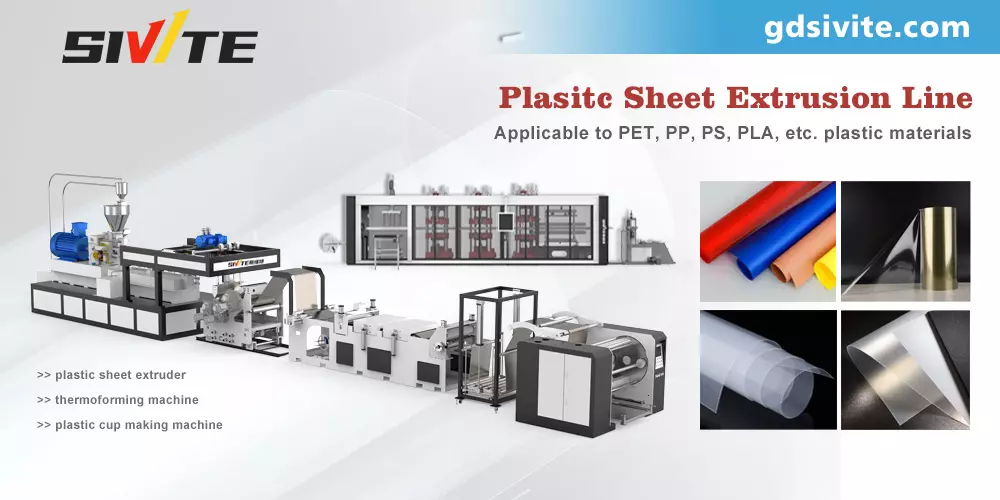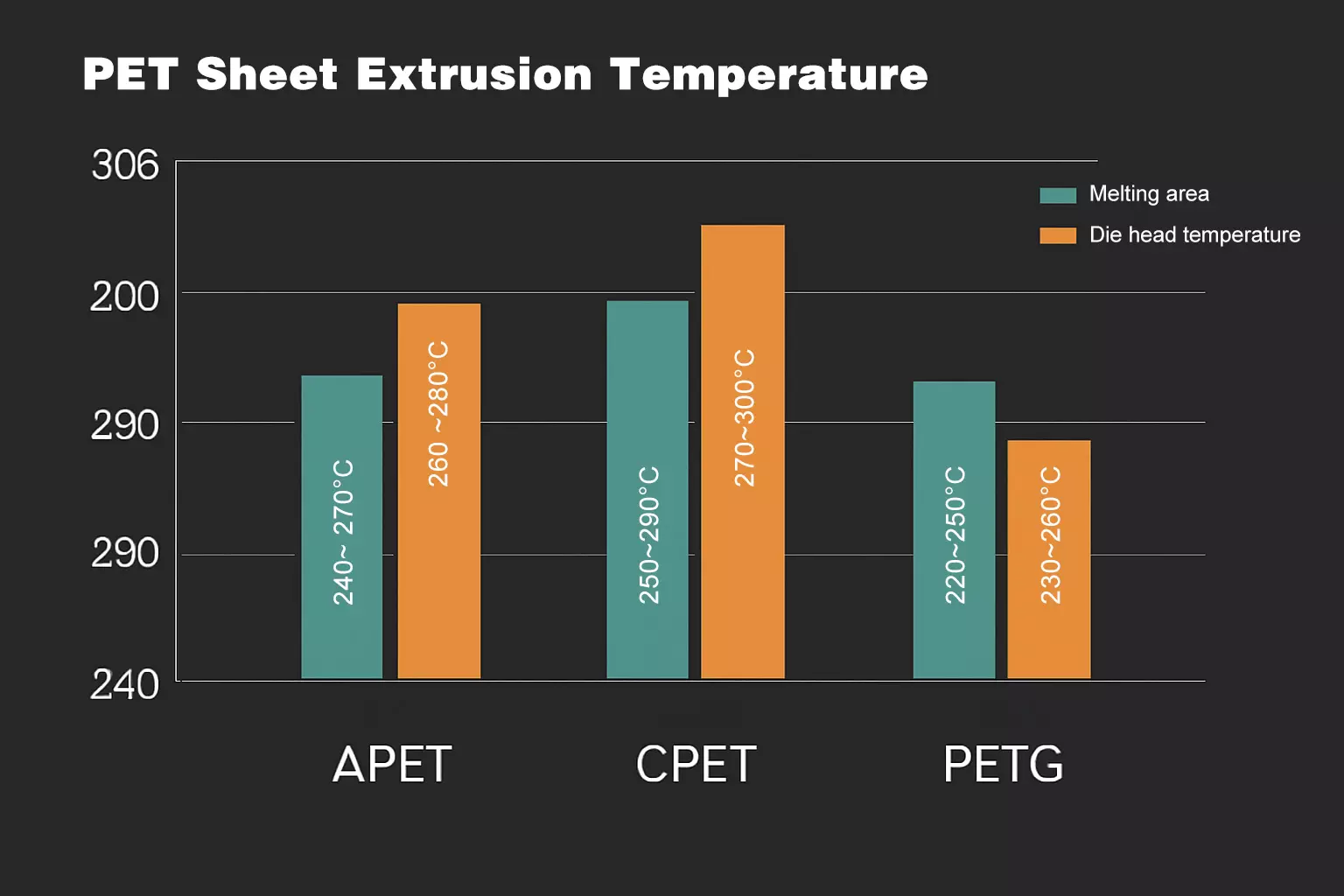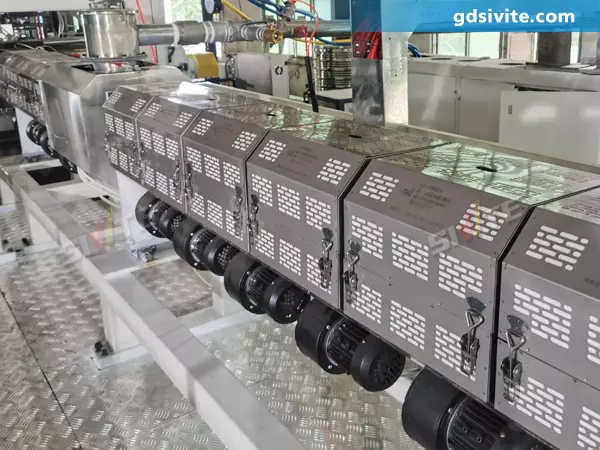What is the Extrusion Temperature for PET Sheet? APET, CPET, PETG Guide
PET (polyethylene terephthalate) is a widely used thermoplastic polymer known for its strength, transparency and recyclability. It is usually processed into films, packaging and various industrial products using PET sheet extruders. One of the most critical factors in the PET extrusion process is temperature control, as it directly affects the quality and performance of the material. Too high or too low a temperature will affect the flow characteristics of the material, resulting in quality defects in the final product.
According to different application scenarios, PET is further subdivided into different materials such as (APET, CPET, PETG), so its optimal extrusion temperature is different. So how can a PET sheet extruder ensure precise thermal management for high-quality output!

Before we delve into the extrusion temperature, it is important to understand the different types of PET:
1. APET (amorphous PET) – APET is known for its transparency and flexibility and is commonly used in food packaging, blister packaging and clamshell containers.
2. CPET (crystalline PET) – This variant has higher heat resistance and is suitable for making ovenable food trays and microwave-safe containers.
3. PETG (ethylene glycol modified PET) – PETG has higher impact resistance and transparency and is widely used in medical packaging, signage and 3D printing.
Each PET requires specific extrusion conditions to ensure optimal sheet forming, extrusion temperature for APET, CPET and PETG.
The extrusion temperature of PET sheet depends on the material type and the PET sheet extruder used. The following are the recommended temperature ranges:
1. APET extrusion temperature
- Barrel area: 240°C – 270°C (464°F – 518°F)
- Die temperature: 260°C – 280°C (500°F – 536°F)
APET requires precise temperature control to maintain its amorphous structure and transparency. Overheating can cause discoloration, while insufficient heating can result in poor melt flow.

2. CPET Extrusion Temperature
- Barrel Zone: 250°C – 290°C (482°F – 554°F)
- Die Temperature: 270°C – 300°C (518°F – 572°F)
Due to its crystalline nature, CPET requires higher temperatures. Proper heating ensures uniform crystallization, which enhances thermal stability for oven-safe applications.
3. PETG Extrusion Temperature
- Barrel Zone: 220°C – 250°C (428°F – 482°F)
- Die Temperature: 230°C – 260°C (446°F – 500°F)
PETG has a lower melting point than standard PET, making it easier to process while maintaining excellent impact resistance.
Importance of Using the Right PET Sheet Extruder
A high-quality PET sheet extruder is essential to maintain a constant temperature and achieve uniform sheet thickness. Key features of PET sheet extruders include:
_ Precise temperature control to ensure consistent heating in all zones.
_ Efficient screw design to optimize melt flow and reduce degradation.
_ Advanced cooling systems to help achieve desired sheet properties.
Factors Affecting PET Sheet Extrusion:
The extrusion process is affected by several factors, including:
- Material Drying – PET is hygroscopic and must be dried (typically at 120°C - 150°C) prior to extrusion to prevent defects.
- Screw speed – affects shear heating and residence time.
- Cooling rate – determines final sheet properties (e.g., crystallinity for CPET).

The Role of PET Sheet Extruders in Achieving Optimal Results
Investing in a high-quality PET sheet extruder is essential to achieving consistent results in PET sheet production. These machines are equipped with advanced temperature control systems that can precisely adjust the temperature based on the type of PET material being processed. Whether you are using APET, CPET, or PETG, a well-calibrated extruder ensures that the material is heated to the optimal temperature, thereby avoiding problems such as material degradation, inconsistent sheet thickness, and poor surface quality.
In summary, understanding the extrusion temperature of different types of PET sheets (APET, CPET, and PETG) is essential to producing high-quality products. By maintaining the correct extrusion temperature for each type of PET, manufacturers can ensure that their PET sheet extruders perform at their best. The right temperature not only improves the appearance and durability of the final product, but also helps to streamline the manufacturing process, reduce waste, and improve overall efficiency.
If you also have needs for PET sheet extrusion, please contact us!
